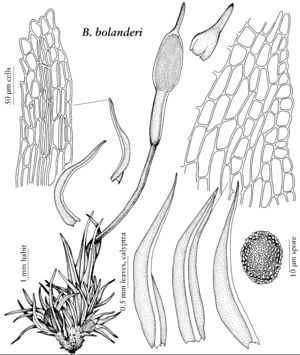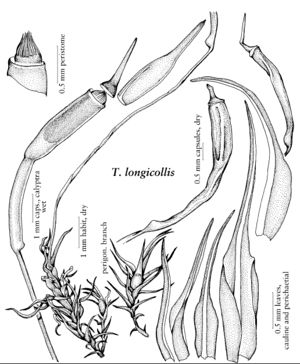Bruchiaceae
Plants minute or merely small, gregarious to densely tufted. Stems erect, simple or branching, with a central strand. Leaves mostly lanceolate or subulate, straight or somewhat curved, base oblong to ovate; in several rows; margins plane, entire or serrulate distally; costa single, well developed, subpercurrent to shortly excurrent as a sometimes roughened or denticulate subula, in section poorly differentiated or with 1 row of guide cells and 2 (sub-) stereid bands, adaxial band much reduced; lamina cells smooth or abaxially papillose; basal-cells broader, narrower towards the margins, those of basal angles not differentiated or forming a marginal border; distal cells short to long-rectangular, walls firm. Specialized asexual reproduction not known. Sexual condition autoicous or paroicous [dioicous]; perigonia axillary or on short branches adjacent to perichaetia or basal on the plant; perichaetial leaves usually differentiated, longer and somewhat sheathing. Seta short-to-elongate, usually yellow or brown; capsules immersed to exerted, cylindric or obovate with a distinct inflated-tapering to elongate neck, erect to curved; cleistocarpous, gymnostomous, or peristomate; annulus, when present, usually of 2–3 rows of larger cells, commonly revoluble; peristome, when present, single, of 16 simple, forked, or perforate teeth; operculum,when present, obliquely long-rostrate. Calyptra cucullate or mitrate. Spores often large, spheric to ovoid or weakly reniform, finely to coarsely papillose, spiculate, reticulate, or pitted.
Distribution
Cosmopolitan, greatest occurrence in temperate regions
Discussion
Genera 4, species ca. 140 (2 genera, 16 species in the flora).
Species of Bruchiaceae commonly occur on soil, often as colonizers. The family was well-characterized by W. R. Buck (1979), who recognized four genera and suggested a transitional position between Dicranaceae and Ditrichaceae. The two genera represented in the flora area are quite different but share the salient well-developed capsule neck.
Selected References
Lower Taxa
Illustrations
Key
| 1 | Capsule cleistocarpic, immersed to short-exserted, neck conic to ovate. | Bruchia |
| 1 | Capsule stegocarpic, long-exserted, neck conic to long-cylindric. | Trematodon |



